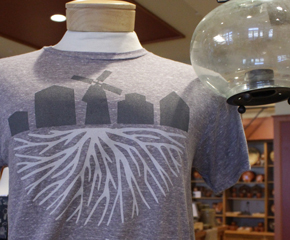
H. J. Heinz Company Collection
The H.J. Heinz Company Collection, 1874-1990, contains photographic prints, advertising layouts, publications, sales training and employee information, product shipping records, photograph albums, scrapbooks, and account books that document the history of the company, the products its produced, and the family history of the founder.
Biographical / Historical Note
Henry John Heinz (1844-1919), a pioneer in the food processing industry, established Heinz, Noble & Co. in 1869 with partner L. Clarence Noble to make and sell processed foods. Horseradish was the company’s first product of a quickly expanding line....
MoreHenry John Heinz (1844-1919), a pioneer in the food processing industry, established Heinz, Noble & Co. in 1869 with partner L. Clarence Noble to make and sell processed foods. Horseradish was the company’s first product of a quickly expanding line. As the business grew, the company headquarters moved from Sharpsburg to Pittsburgh, Pennsylvania. However, financial difficulties forced company bankruptcy in 1875.
The following year, Henry J. Heinz established a new company, the F & J Heinz Co., with his brother John and cousin Frederick. The organization prospered and expanded both its product line and its territory, setting up branch factories across the United States. Heinz also established the first of many foreign branches in London, England, in the 1880s. By 1888, Henry J. Heinz bought out his two partners and reorganized the company under the name H.J. Heinz Company.
Henry John Heinz was closely involved with nearly every phase of the corporation. In the late 19th Century, when many food products were still sold in bulk, Heinz developed a strong corporate image, aggressively keeping the company name and trademark in the public eye with extensive and innovative advertising campaigns. By organizing his own loyal traveling sales force, Heinz appealed directly to both the retailer and the consumer, thus making the role of an anonymous wholesaler unnecessary. The Heinz sales force was one of the first to receive rigorous training in conducting in-store consumer taste tests. The company also pioneered the concept of the factory tour as a way of publicizing its products.
Heinz was a pioneer in organizing large scale production. The H.J. Heinz Co. took full advantage of new technology in continuous process machinery and the expanding transportation network. The Heinz industrial complex included preserving kitchens, bottling and packing facilities, a box factory with automatic mailing machines, and a can factory.
Henry J. Heinz insisted that properly prepared food be sanitary and chemical-free. He vigorously supported and promoted the pure food movement to set government standards for the food preservation industry, a campaign which culminated in the Pure Food and Drug Act of 1906.
Heinz was also an innovator in creating a clean, pleasant working environment for his employees. The physical comforts of the Heinz plant, hours, and pay were exceptional for their time. The company provided dressing rooms with showers, an employee dining room, a two-bed hospital, a library, free self-improvement courses, a gymnasium, swimming pool, and a roof garden.
In 1904, Henry John Heinz moved his Sharpsburg, Pennsylvania, childhood home, the site of his first food processing company, to the Pittsburgh headquarters where it served as a company museum and stop on the visitor factory tours. In 1983, the Heinz House was moved to Greenfield Village in Dearborn, Michigan. With the house, the Heinz Co. donated over 2,700 items, dating from the 1870s to the 1940s.
LessScope and Content Note
The H.J. HEINZ COMPANY COLLECTION (46.15 cubic ft.) documents the company’s product development, advertising campaigns, and related public relations activities. The collection of textual and graphic materials includes photographic prints, advertisement,...
MoreThe H.J. HEINZ COMPANY COLLECTION (46.15 cubic ft.) documents the company’s product development, advertising campaigns, and related public relations activities. The collection of textual and graphic materials includes photographic prints, advertisement, advertising layouts, ledgers, corporate publications, and salesmen’s manuals. Related trade catalogs, trade cards, and recipe booklets are located within other collections of like materials in the Benson Ford Research Center’s collections.
When this collection was arranged in 1993, the PHOTOPRINTS SERIES and ADVERTISING LAYOUTS SERIES were first organized by the size of the items, and then according to subject. To ease use for researchers, this arrangement has been reversed. Materials in those series are now arranged by subject, with oversize materials included after the standard sized materials. Due to this, box numbers may appear multiple times, and some subjects may be repeated, especially amongst the oversize boxes.
The H.J. HEINZ PHOTOPRINTS SERIES (9.3 cubic ft.) contains an assortment of photographic prints dating from 1870 to 1935. They convey a comprehensive picture of the company’s operations and illustrate aspects of H.J. Heinz’s personal life. Topics covered include acquaintances and friends, dwellings, exhibitions, family, farms and farming, and the H.J. Heinz Co. Of note are the many images of work being done at the H.J. Heinz factories and of the people who worked there.
The H.J. HEINZ COMPANY ADVERTISING LAYOUTS SERIES (20.25 cubic ft.) includes mock-ups for print advertisements, as well as decorative motifs and test that could be used in advertisements, that were created between 1905 and 1935. They consist of overpainted photoprints and original artwork, in ink, gouache, and paint, and many contain revisions notes to the artist written in the margins. Images of company buildings and processes, farms and farming, Heinz products, consumers and employees, and transportation were often used in these layouts.
The H.J. HEINZ COMPANY ADVERTISEMENTS SERIES (1.1 cubic ft.) contains advertisements for the business in their completed form. Consisting primarily of street car advertisements and magazine tear sheets for Heinz products, it also includes two mounted advertisements and a photostat regarding Heinz visitor tours.
The COMPANY AND PERSONAL PAPERS SERIES (3.1 cubic ft.) provides information about company operations and Heinz family interests from 1874 to 1969. Included among the records are sales training materials, employee information, and product shipping records. The materials are arranged with the early companies, Heinz, Noble & Co. and F & J Heinz, listed first. The H.J. Heinz Company papers, which comprise the majority of the series, are arranged alphabetically by type of record. Additional business records can be found in the H.J. HEINZ COMPANY BUSINESS LEDGERS SERIES.
The H.J. HEINZ COMPANY PRINTED MATERIALS SERIES (1.5 cubic ft.) includes memorials and tributes, primarily to H.J. Heinz, printed programs for a variety of company and community events, and publications of the H.J. Heinz Company. The memorials and tributes are arranged in chronological order; the programs and publications are in alphabetical order.
The H.J. HEINZ COMPANY ALBUMS AND SCRAPBOOKS SERIES (8.5 cubic ft.) documents company operations, advertising strategies, employee recognition activities, and World War II production efforts. The albums contain a variety of materials, including photographic prints, product labels, clippings, department layouts, postcards, trade cards, and booklets. While some of these books have been placed in boxes, others are shelved unboxed. For each item, a brief description of the contents and inclusive dates are provided. Individual accession numbers for each item are also given to facilitate identification and retrieval.
The H.J. HEINZ COMPANY BUSINESS LEDGERS SERIES (2.4 cubic ft.) records activities from 1876 to 1944, and includes account books, building records, sales convention records, stock inventories, and a travelers register. A brief description of the contents and inclusive dates are provided for each ledger. Individual accession numbers are also given to facilitate identification and retrieval.
LessCollection Details
Object ID: 53.41.0
Creator: H.J. Heinz Company
Inclusive Dates: 1874-1990
Bulk Dates: 1900-1935
Size: 46.15 cubic ft. (66 boxes, 27 volumes, and 1 framed item)
Language: English
Collection Access & Use
Item Location: Not Currently On Exhibit
Access Restrictions: The collection is open for research.
Credit: From the Collections of The Henry Ford. Gift of H.J. Heinz Co.
Digitized Artifacts From This Collection
In many cases, not all artifacts have been digitized.
Contact us for more information about this collection.
Second Floor of H. J. Heinz Company Stables, Pittsburgh, Pennsylvania, circa 1910
Artifact
Photographic print
Summary
The H.J. Heinz Company spared no expense when caring for its Percheron horses. The processed food manufacturer stabled horses on the second floor of a three-story "equine palace" in Pittsburgh. Grooms spread high-quality bedding, as this photograph shows, to help keep their charges clean between shifts hitched to Heinz delivery wagons.
Creators
Object ID
53.41.949
Credit
From the Collections of The Henry Ford. Gift of H.J. Heinz Co.
Location
By Request in the Benson Ford Research Center
Get more details in Digital Collections at:
Second Floor of H. J. Heinz Company Stables, Pittsburgh, Pennsylvania, circa 1910
What is The Henry Ford?
The national attraction for discovering your ingenuity while exploring America’s spirit of innovation. There is always much to see and do at The Henry Ford.


Employees in Preserves Department of Main Plant, H. J. Heinz Company, Pittsburgh, Pennsylvania, circa 1920
 Details
Details
Employees in Preserves Department of Main Plant, H. J. Heinz Company, Pittsburgh, Pennsylvania, circa 1920
Artifact
Photographic print
Summary
Before complete mechanization of the manufacturing process, many tasks at the Heinz factory were done by hand. The H.J. Heinz Company documented the many departments of the manufacturing process through photographs. This photograph shows employees in the Preserves Department. Instead of glass jars or bottles, fruit preserves and butters were sold in stoneware crocks.
Creators
Object ID
53.41.2211
Credit
From the Collections of The Henry Ford. Gift of H.J. Heinz Co.
Location
By Request in the Benson Ford Research Center
Get more details in Digital Collections at:
Employees in Preserves Department of Main Plant, H. J. Heinz Company, Pittsburgh, Pennsylvania, circa 1920
What is The Henry Ford?
The national attraction for discovering your ingenuity while exploring America’s spirit of innovation. There is always much to see and do at The Henry Ford.
A. L. Ernest Grocery Store Floor Display of Heinz Products, York, Pennsylvania, circa 1930
Artifact
Photographic print
Summary
H. J. Heinz was at the forefront of creative marketing in the manufactured food industry. He developed a comprehensive advertising strategy that included elaborate product displays in local grocery stores. Shoppers were greeted with colorful posters and meticulously designed floor-to-ceiling pyramids of canned and jarred products created by Heinz salespeople.
Creators
Keywords
Object ID
53.41.718
Credit
From the Collections of The Henry Ford. Gift of H.J. Heinz Co.
Location
By Request in the Benson Ford Research Center
Get more details in Digital Collections at:
A. L. Ernest Grocery Store Floor Display of Heinz Products, York, Pennsylvania, circa 1930
What is The Henry Ford?
The national attraction for discovering your ingenuity while exploring America’s spirit of innovation. There is always much to see and do at The Henry Ford.
Pastoor's Market Store Floor Display of Heinz Products, Grand Rapids, Michigan, circa 1930
Artifact
Photographic print
Summary
H. J. Heinz was at the forefront of creative marketing in the manufactured food industry. He developed a comprehensive advertising strategy that included elaborate product displays in local grocery stores. Shoppers were greeted with colorful posters and meticulously designed floor-to-ceiling pyramids of canned and jarred products created by Heinz salespeople.
Creators
Object ID
53.41.724
Credit
From the Collections of The Henry Ford. Gift of H.J. Heinz Co.
Location
By Request in the Benson Ford Research Center
Get more details in Digital Collections at:
Pastoor's Market Store Floor Display of Heinz Products, Grand Rapids, Michigan, circa 1930
What is The Henry Ford?
The national attraction for discovering your ingenuity while exploring America’s spirit of innovation. There is always much to see and do at The Henry Ford.


Employees in the Ketchup Department, H. J. Heinz Company, Pittsburgh, Pennsylvania, circa 1910
 Details
Details
Employees in the Ketchup Department, H. J. Heinz Company, Pittsburgh, Pennsylvania, circa 1910
Artifact
Photographic print
Summary
Before complete mechanization of the manufacturing process, many tasks at the Heinz factory were done by hand. The H. J. Heinz Company documented the many departments of the manufacturing process through photographs. This photograph shows employees working in the Ketchup Department.
Creators
Object ID
53.41.1056
Credit
From the Collections of The Henry Ford. Gift of H.J. Heinz Co.
Location
By Request in the Benson Ford Research Center
Get more details in Digital Collections at:
Employees in the Ketchup Department, H. J. Heinz Company, Pittsburgh, Pennsylvania, circa 1910
What is The Henry Ford?
The national attraction for discovering your ingenuity while exploring America’s spirit of innovation. There is always much to see and do at The Henry Ford.
Painted Delivery Wagon, H. J. Heinz Company, London, England, circa 1900
Artifact
Photographic print
Summary
Henry J. Heinz rarely missed an opportunity to raise customer awareness for his line of packaged foods. His promotional schemes were innovative and often flamboyant. This brightly painted wagon, used for deliveries or sales calls, featured Heinz tomato products and some of the famous "57 Varieties". Paired with a handsome team of Heinz draft horses, this commercial vehicle doubled as a remarkable moving advertisement.
Place of Creation
Keywords
Object ID
53.41.2167
Credit
From the Collections of The Henry Ford. Gift of H.J. Heinz Co.
Location
By Request in the Benson Ford Research Center
Get more details in Digital Collections at:
Painted Delivery Wagon, H. J. Heinz Company, London, England, circa 1900
What is The Henry Ford?
The national attraction for discovering your ingenuity while exploring America’s spirit of innovation. There is always much to see and do at The Henry Ford.
Tomato Seedlings in Greenhouse, circa 1910
Artifact
Photographic print
Summary
Entrepreneur H.J. Heinz recognized that producing the highest quality products began with where the ingredients were grown and how they were harvested. He took great care in managing every aspect of the process to ensure the best ingredients for his line of pickled foods, preserves, and condiments. This photograph shows one step in the tomato harvesting process.
Creators
Keywords
Object ID
53.41.861
Credit
From the Collections of The Henry Ford. Gift of H.J. Heinz Co.
Location
By Request in the Benson Ford Research Center
Get more details in Digital Collections at:
Tomato Seedlings in Greenhouse, circa 1910
What is The Henry Ford?
The national attraction for discovering your ingenuity while exploring America’s spirit of innovation. There is always much to see and do at The Henry Ford.
Bean Field in Michigan, circa 1925
Artifact
Photographic print
Summary
Entrepreneur H.J. Heinz recognized that producing high-quality products began with growing the best ingredients. He managed every aspect of the process from seed selection to harvest to ensure that only the best ingredients became Heinz pickled foods, preserves, and condiments. This photograph shows a bean field where beans for Heinz products were grown.
Creators
Keywords
Object ID
53.41.887
Credit
From the Collections of The Henry Ford. Gift of H.J. Heinz Co.
Location
By Request in the Benson Ford Research Center
Get more details in Digital Collections at:
Bean Field in Michigan, circa 1925
What is The Henry Ford?
The national attraction for discovering your ingenuity while exploring America’s spirit of innovation. There is always much to see and do at The Henry Ford.
Worker Harvesting Apples, circa 1925
Artifact
Photographic print
Summary
Entrepreneur H.J. Heinz recognized that producing the highest quality products began with where the ingredients were grown and how they were harvested. He took great care in managing every aspect of the process to ensure the best ingredients for his line of pickled foods, preserves, and condiments. This photograph shows one step in the apple harvesting process.
Creators
Keywords
Object ID
53.41.893
Credit
From the Collections of The Henry Ford. Gift of H.J. Heinz Co.
Location
By Request in the Benson Ford Research Center
Get more details in Digital Collections at:
Worker Harvesting Apples, circa 1925
What is The Henry Ford?
The national attraction for discovering your ingenuity while exploring America’s spirit of innovation. There is always much to see and do at The Henry Ford.
















